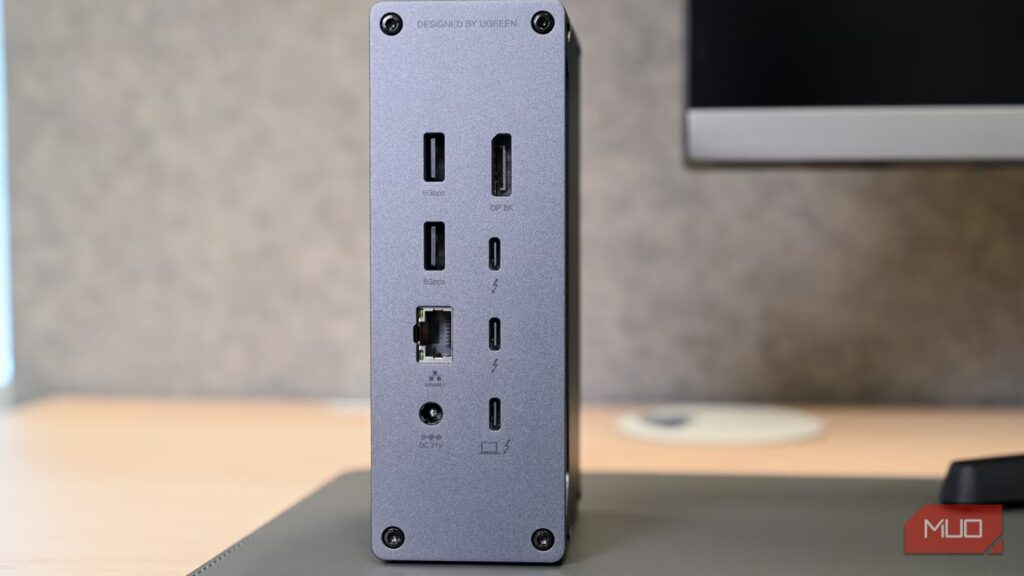You know that moment when you discover something obvious and suddenly wonder how you missed it for so long? That was me with USB ports. Like most people, I use USB ports on all my devices, including laptops, monitors, TVs, routers, and everything else. But I didn’t pay attention to the icons and symbols printed beside them.
However, knowing and not knowing makes a bigger difference than I ever expected. It’s the detail that can save you from frustrations and can help you make the most of your device’s capabilities.
Why symbols on USB ports matter
Small icons make a big difference
Gavin Phillips/MakeUseOfCredit: Gavin Phillips/MakeUseOf
For years, I treated every USB port on my devices based on its type. I never paid much attention to those little symbols on top or along the sides of those ports, assuming they didn’t really matter much. But I couldn’t be more wrong. These icons are there to show which type of USB port it is and what it can do. This can help you decide whether it’s better suited for charging devices, transferring files, or carrying video signals.
Now, this doesn’t mean you can’t use a port the “wrong” way. These ports still work just fine. But when you know what those tiny symbols mean, you’ll be able to use the USB ports on your devices the way they were designed to.
What different USB icons actually mean
Decoding the symbols you’ve seen a thousand times
There’s a reason why manufacturers put those tiny symbols next to USB ports. And once you start paying attention, you’ll see the symbols around your USB ports in a completely different way.
Symbol
Meaning
USB-IFCredit: USB-IF
You may have seen it at least thousands of times. On your devices, this indicates a USB 2.0 port, also known as Hi-Speed port, which offers modest data transfer speeds of 480 Mbps.
USB-IFCredit: USB-IF
SS stands for SuperSpeed. This appears on USB 3.0 ports and tells you the port supports faster data transfer of up to 5 Gbps.
USB-IFCredit: USB-IF
If you spot SS with 10 or 20, the number refers to the maximum gigabits per second the port can handle. These are typically USB 3.1 Gen 1 or USB 3.1 Gen 2 ports.
IntelCredit: Intel
This icon means the USB port has fast charging capabilities. On some laptops, it can also indicate Thunderbolt support, which combines power, data, and video capabilities.
DisplayPortCredit: DisplayPort
The DisplayPort icon indicates the USB port also supports video output. This means you can use it to plug in an external monitor or projector, though you’ll need to use the right USB-C cable.
USB-IFCredit: USB-IF
The latest USB standard USB4 ports have a half circle with a number (20 or 40) printed beside it. These are almost always USB-C ports, and the number tells you the maximum speed the port can handle, such as 20 Gbps or 40 Gbps.
Now I use them wisely
And you should too
Credit: James Bruce / MakeUseOf
Once I finally understood what all those tiny symbols meant, I stopped treating every port like it was identical. Now I look at my USB ports like a toolbox where each slot has a specific strength.
For instance, the classic trident symbol, which marks a USB 2.0 port, is best for basics like peripherals such as keyboard, mouse, and other low-powered accessories. They don’t need blazing speed, so there’s no point in wasting a faster port for them.
Ports with the SS mark are now my go to for storage devices such as a flash drive or an external drive, since they provide better file transfer speeds. And if I see SS with 10 or 20, I save those for devices that can benefit from the extra speed.
USB-C ports with a lightning icon are ideal for fast charging or powering a smartphone. Any port with the DP symbol is what I use for connecting my monitor. And I try to keep USB4 or Thunderbolt ports vacant for power-hungry devices, like docking stations or USB hubs.
You should also pay attention to port colors
They also reveal the same thing
Credit: Andy Cormier / MakeUseOf
Besides symbols and icons, the USB port colors can also reveal what kind of performance you can expect. Different colors, such as black, blue, red, yellow, and even teal, can indicate USB port type. These are only for USB-A ports, so for USB-C ports, you’ll still need to rely on the symbols and icons.
Also, the USB port colors are not standardized by USB-IF (the organization behind USB), which means manufacturers can interpret them a bit differently. Still, most well-known brands follow the same general pattern, so the colors will usually point you in the right direction.
Even so, the most accurate way to identify a port is through the device documentation. When in doubt, a quick check in the manual or online spec sheet will tell you exactly what each port supports.
After all this time of overlooking those tiny markings, I finally get why they’re there and why they matter. If you too have been ignoring those icons the way I did, make sure to take a second look at the ports around you.

